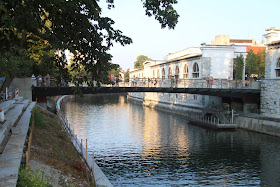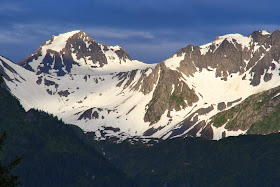 |
| Wikipedia |

Down on the Kenai peninsula, south of Anchorage and in a beautiful fjord-like idyllic harbor is Seward. From air it looks tiny, and it is! It's the end of the road, home to the Exit Glacier (which emerges from the Harding icefield), the Seward Mount Marathon Race (and when you see how steep the mountain you realise just how insane this race is going up 3000m and back in less than an hour ever since 1915!) and a superb animal center (Alaska SeaLife Center opened in 1998 and is part of the legacy of the Exxon Valdez spill) with puffins, seals and other typical Alaskan wildlife. It is also mile 0 of the historic Iditarod Dogsled Trail to Nome and the Alaska Railroad terminus, as well as being the gateway to Kenai Fjords National Park.

William H. Seward was secretary of state under Abraham Lincoln and Andrew Johnson, and it was after him that this wild outpost was named, as he fought to gain the territory of Alaska from Russia, although the area was settled long before that by Alexander Baranov of the Shelikhov-Golikov company (Russian-American Company), who established a fur trade post on Resurrection Bay.

What is it good for? Fishing! Lots of rain! Less than 3000 people call Seward home, which is not much growth from around 500 in 1910. It's basically a quaint little Alaskan port and military base town at the edge of beautiful mountains and spectacular scenery.
All 127 miles of Seward Highway is a spectacular drive and a scenic byway, and Seward itself is a destination for most Alaska cruises. Its modern incarnation began with the establishment of the railway in 1903 due to its ice-free port, and the whole area was significantly damaged in a 1964 earthquake.
Source: http://en.wikipedia.org/wiki/Seward,_Alaska
http://en.wikipedia.org/wiki/Mount_Marathon_Race
http://en.wikipedia.org/wiki/Alaska_SeaLife_Center
Lonely Planet Alaska, 9th Edition, 2009
 Most people in this part of Guatemala are here to visit the famous Tikal (#954), but it would be tragic to pass by Flores without a stop. Where else in the world is there a highly developed colonial island town in the middle of a lake? Lago Petén Itzá is in El Petén Province in North Eastern Guatemala, and Flores is separated from the twin towns of Santa Elena and San Benito by a causeway. The village just north across the lake is San Miguel.
Most people in this part of Guatemala are here to visit the famous Tikal (#954), but it would be tragic to pass by Flores without a stop. Where else in the world is there a highly developed colonial island town in the middle of a lake? Lago Petén Itzá is in El Petén Province in North Eastern Guatemala, and Flores is separated from the twin towns of Santa Elena and San Benito by a causeway. The village just north across the lake is San Miguel. In Pre-Columbian times, Flores was the Maya city of Nojpetén. The Itza left the Yucatán region in the 13th century and built the city later known as Tayasal as their capital. They called it Noh Petén, literally "City Island". It was also called Tah Itzá, or Place of the Itzá. It was on this island that the last Maya held out as an independent Maya state against the Spanish conquerors despite Hernan Cortes visiting the island in 1541. It was not conquered until 1697, when they attacked via boats. Many Itzá people fled and hid in the jungle for years.
In Pre-Columbian times, Flores was the Maya city of Nojpetén. The Itza left the Yucatán region in the 13th century and built the city later known as Tayasal as their capital. They called it Noh Petén, literally "City Island". It was also called Tah Itzá, or Place of the Itzá. It was on this island that the last Maya held out as an independent Maya state against the Spanish conquerors despite Hernan Cortes visiting the island in 1541. It was not conquered until 1697, when they attacked via boats. Many Itzá people fled and hid in the jungle for years. 



















































